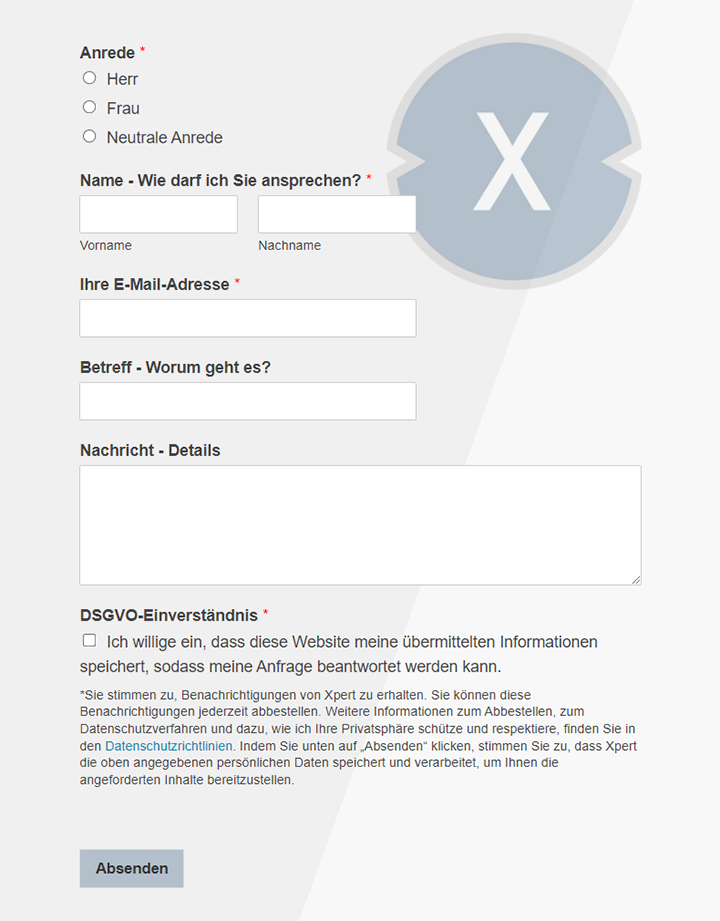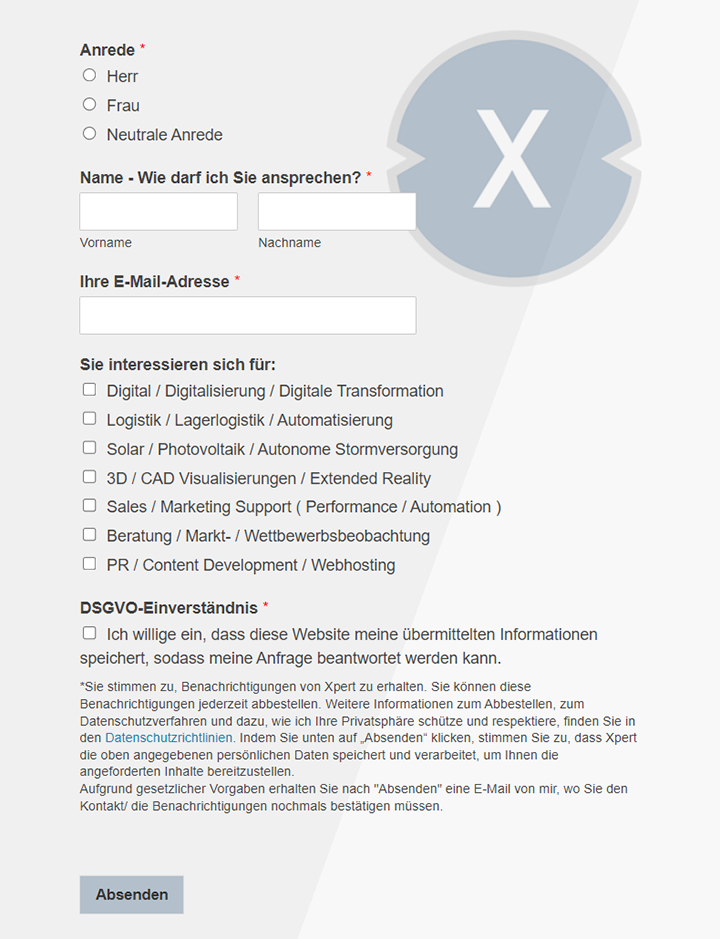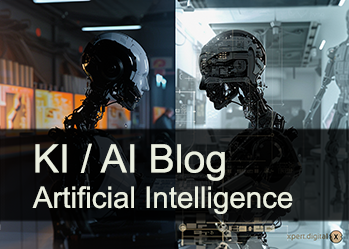The interrelationship between physical production and digital infrastructure (AI & data center)
Xpert pre-release
Language selection 📢
Published on: August 4, 2025 / Updated on: August 4, 2025 – Author: Konrad Wolfenstein
Between factory hall and data center: New markets emerge
Production and IT: The interaction that strengthens Germany
What is the relationship between manufacturing and digital infrastructure? This question arises in light of increasing digitalization and the growth of data centers, cloud computing, and artificial intelligence. The following section examines the complex interrelationships between physical production and digital infrastructure, focusing on the situation in Germany in an international comparison.
Suitable for:
- Technological leadership or application expertise? The advantages of being a leading technology developing country or a technology adopting country
The fundamental dependency: Why can a factory exist without the cloud, but not vice versa?
What makes physical production the basis of digital value creation?
Physical production forms the foundation for digital value creation for several reasons. First, the manufacturing industry generates real products and services that have a direct benefit for end consumers. A factory can theoretically operate without cloud infrastructure and data centers, as has been the case for decades. Conversely, however, a data center without a manufacturing industry makes no economic sense.
IT, digitalization, and artificial intelligence are increasingly necessitating the need for physical manufacturing or production facilities to monetize their value. Cloud computing and data centers are enablers and multipliers of value creation, but they do not create physical goods themselves.
What role do data centers play in the modern economy?
Data centers serve as the backbone of digitalization. Hardly any company or private household can function without the services of data centers, and even public administration can no longer function without them. They enable the storage, processing, and provision of data that is essential for modern business processes.
Nevertheless, their function remains subservient: They support and optimize processes in the real economy, but do not create material goods themselves. Value creation only arises through the application of digital technologies in physical production, trade, or services.
Suitable for:
- Is Germany now a leading technology country or not? An attempt at explanation, especially using the example of artificial intelligence (AI)
The speed advantage of digital infrastructure
How do setup times differ between data centers and production sites?
A data center can be demonstrably built faster than a manufacturing facility. While the construction of a traditional data center typically takes around 400 days, modular concepts can reduce this time to just 2-3 months.
In contrast, the construction of a modern production facility takes several years. Mercedes-Benz's Factory 56 in Sindelfingen, for example, took 2.5 years to build. The construction of the Tesla Gigafactory in Berlin-Brandenburg was also a multi-year project.
Why is faster data center construction not necessarily an advantage?
The speed of data center construction is not an advantage, because the proliferation of clouds and data centers must be proportional to the growth of manufacturing facilities to ensure they are profitable and do not cannibalize themselves later. An oversupply of digital infrastructure without corresponding demand from the manufacturing sector leads to overcapacity and uneconomical investments.
Location requirements in comparison
What different requirements do data centers and manufacturing companies place on their locations?
Data centers can be set up anywhere sooner or later, without the major constraints of manufacturing. The most important location factors for data centers are:
- Property size (often from 1 hectare for hyperscale data centers)
- Distance to the DE-CIX internet exchange in Frankfurt
- Power availability and proximity to substations
- Distance from potential sources of danger
Manufacturing companies, on the other hand, must be in harmony with energy infrastructure, science, and schools. They need:
- Qualified workforce and proximity to training institutions
- Transport connections for freight transport
- Suppliers and customers within easy reach
- Specific infrastructure depending on the industry
Suitable for:
- Is Silicon Valley overrated? Why Europe's old strength is suddenly worth its weight in gold again – AI meets mechanical engineering
How does the varying flexibility of locations affect regional development?
If the infrastructure for manufacturing is insufficient, the success of the manufacturing industry is limited – and thus also dependent on data centers, IT, AI, and digitalization. Compared to production facilities, data centers create few on-site jobs. Even large data centers can manage with a small number of employees to maintain the facility.
Germany in international comparison
How does Germany compare to other countries in terms of industrial production?
At almost 20%, Germany has one of the highest shares of manufacturing in GDP worldwide. In 2024, the manufacturing sector contributed 19.7% to gross value added in Germany. By comparison, the share in France was 10.6% and in the USA 17.5%.
If you break down the EU, US, and China into individual countries and regions, Germany ranks first, ahead of California and its Silicon Valley. Manufacturing, or industry, accounts for 11% of California's GDP, while Germany accounts for almost twice that, with a share of just under 20%.
How does the IT sector compare between Germany and California?
The IT sector’s share of gross domestic product differs significantly between Germany and California:
- In Germany, the share of ICT/IT in GDP was around 4.5% in 2024
- In California, the technology sector accounts for around 17-19% of total GDP
In fact, Silicon Valley accounts for over 30% of California's GDP. The IT share of California's GDP is about four times higher than in Germany.
Suitable for:
🎯📊 Integration of an independent and cross-data source-wide AI platform 🤖🌐 for all company matters

Integration of an independent and cross-data source-wide AI platform for all company matters – Image: Xpert.digital
Ki-Gamechanger: The most flexible AI platform – tailor-made solutions that reduce costs, improve their decisions and increase efficiency
Independent AI platform: Integrates all relevant company data sources
- This AI platform interacts with all specific data sources
- From SAP, Microsoft, Jira, Confluence, Salesforce, Zoom, Dropbox and many other data management systems
- Fast AI integration: tailor-made AI solutions for companies in hours or days instead of months
- Flexible infrastructure: cloud-based or hosting in your own data center (Germany, Europe, free choice of location)
- Highest data security: Use in law firms is the safe evidence
- Use across a wide variety of company data sources
- Choice of your own or various AI models (DE, EU, USA, CN)
Challenges that our AI platform solves
- A lack of accuracy of conventional AI solutions
- Data protection and secure management of sensitive data
- High costs and complexity of individual AI development
- Lack of qualified AI
- Integration of AI into existing IT systems
More about it here:
Digital opportunities for Germany: Why IT growth is outpacing industrial progress
The opportunities for Germany
Why does Germany have a better chance of catching up in the IT sector than California does in industry?
The chances that Germany will catch up faster in IT, AI, and data centers than California will in manufacturing are far greater. This is due to several factors:
- Industrial base as a foundation: Germany already has a strong industrial base that serves as an application field for digital technologies
- Faster scalability of digital infrastructure: While building industrial capacity takes years and requires specific location factors, digital infrastructures can be built more quickly
- Growth potential: The German IT market is already experiencing strong growth. Growth of 4.6% to €232.8 billion is forecast for 2025.
What levers must Germany pull to catch up with its IT backlog?
If Germany – and especially the EU – pull the right levers, the IT gap with the US can be closed quickly. The following measures are necessary:
- Expansion of digital infrastructure: Accelerated expansion of broadband networks and 5G communication
- Support for data centers: electricity price compensation and simplified approval procedures
- Investments in key technologies: Increased support for AI, cloud computing and quantum technologies
- Digitalization of industry: Consistent implementation of Industry 4.0 concepts
Suitable for:
The role of the EU in the digital single market
What is the significance of the EU internal market for digitalisation?
The EU must all pull together and further advance the other area, the internal market within the EU. The EU Commission has recognized that the internal market must be reformed to advance the digital transformation.
The new internal market strategy aims to:
- Removing the ten biggest obstacles in the internal market
- To advance the digitalisation of the internal market
- To facilitate cross-border digital services
- To develop common standards and norms
What specific work is being done by the EU Commission?
There are enough areas for the EU Commission to finally do more here and put it on the main agenda:
- Digitalization of administration: Implementation of the “once-only” principle and the Single Digital Gateway
- Reducing regulatory hurdles: simplifying cross-border services and reducing bureaucratic burdens
- Promoting digital innovation hubs: Establishing and strengthening the European Digital Innovation Hubs (EDIHs)
- Investments in digital infrastructure: The “Digital Europe” program provides €8.2 billion for digital transformation
Economic importance and added value
How does digitalization contribute to value creation?
Digitalization can significantly increase value creation. Cloud computing alone could generate up to €250 billion in additional value creation and 2.5 million new jobs in the EU by 2020.
In Germany, information technology revenues already reached €152.6 billion in 2024. The software industry is growing particularly strongly, with an increase of 9.5% for 2025.
What role does Industry 4.0 play in sustainability?
Industry 4.0 contributes significantly to sustainable production. 81% of companies say that Industry 4.0 contributes to sustainable production. With accelerated deployment of digital technologies, up to 64 million tons of CO2 can be saved in Germany alone by 2030 – this represents 17% of the total planned CO2 savings under the 2030 climate target.
Energy demand and infrastructure
How is the energy demand of data centers developing?
The energy demand of data centers is continuously increasing. With further capacity expansion, the electricity demand of data centers and IT installations is expected to double from 20 terawatt hours (TWh) in 2023. By 2030, data centers will account for approximately 3.2% of total electricity demand in the EU.
What demands does this place on the energy infrastructure?
- Power availability is a limiting factor for data center development. New requirements include:
- 100% electricity from renewable energies from 2027
- Use of at least 10% waste heat from 2026 (20% from 2028)
- Integration into municipal heating networks
- Development of intelligent energy infrastructures
Labor market and employment
How does employment intensity differ between IT and industry?
The employment structures differ considerably:
- 8 million people work in the manufacturing sector in Germany
- In the IT sector there are 1.183 million employed people
- Data centers themselves create only a few direct jobs on site
What developments can be expected on the labor market?
The IT industry is continuously creating new jobs. An increase of 20,000 new jobs is expected in the ICT sector by 2025. At the same time, the demand for qualified specialists in both sectors is increasing, with the industry benefiting from its established dual training system.
How can Germany strengthen its position as an industrial location with digital competence?
Germany can leverage its unique position by:
- The strong industrial base as an application field for digital innovations
- Targeted investment in the digitalization of production
- The advantages of both worlds combined – German engineering with digital innovation
What role does European cooperation play?
European cooperation is crucial for success. The EU's single market, with 450 million consumers, offers a large domestic market for digital solutions. Common standards, coordinated investments, and the reduction of trade barriers are essential for competitiveness against the US and China.
This analysis shows that physical production and digital infrastructure exist in a symbiotic relationship, with the manufacturing economy forming the foundation. With its strong industrial sector, Germany has an excellent starting point for catching up in the digital field as well. The faster scalability of digital infrastructures compared to the lengthy development of industrial capacities offers Germany the opportunity to catch up with digital pioneers like Silicon Valley. The key will be to set the right political and economic course and leverage the strengths of European cooperation.
We are there for you – advice – planning – implementation – project management
☑️ SME support in strategy, consulting, planning and implementation
☑️ Creation or realignment of the AI strategy
☑️ Pioneer Business Development
I would be happy to serve as your personal advisor.
You can contact me by filling out the contact form below or simply call me on +49 89 89 674 804 (Munich) .
I'm looking forward to our joint project.
Xpert.digital – Konrad Wolfenstein
Xpert.Digital is a hub for industry with a focus on digitalization, mechanical engineering, logistics/intralogistics and photovoltaics.
With our 360° business development solution, we support well-known companies from new business to after sales.
Market intelligence, smarketing, marketing automation, content development, PR, mail campaigns, personalized social media and lead nurturing are part of our digital tools.
You can find more at: www.xpert.digital – www.xpert.solar – www.xpert.plus






























